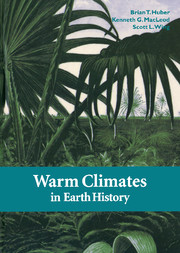Book contents
- Frontmatter
- Contents
- List of contributors
- Preface
- Part 1 Approaches to the study of paleoclimates
- Part II Case studies: latest Paleocene–early Eocene
- 4 Comparison of early Eocene isotopic paleotemperatures and the three-dimensional OGCM temperature field: the potential for use of model-derived surface water δ18O
- 5 Deep-sea environments on a warm earth: latest Paleocene-early Eocene
- 6 Mountains and Eocene climate
- 7 An early Eocene cool period? Evidence for ceontinental cooling during the warmest part of the Cenozoic
- Part III Case studies: Mesozoic
- Part IV Case studies: Paleozoic
- Part V Overview: climate across tectonic timescales
- Index
- Plate section
7 - An early Eocene cool period? Evidence for ceontinental cooling during the warmest part of the Cenozoic
from Part II - Case studies: latest Paleocene–early Eocene
Published online by Cambridge University Press: 06 July 2010
- Frontmatter
- Contents
- List of contributors
- Preface
- Part 1 Approaches to the study of paleoclimates
- Part II Case studies: latest Paleocene–early Eocene
- 4 Comparison of early Eocene isotopic paleotemperatures and the three-dimensional OGCM temperature field: the potential for use of model-derived surface water δ18O
- 5 Deep-sea environments on a warm earth: latest Paleocene-early Eocene
- 6 Mountains and Eocene climate
- 7 An early Eocene cool period? Evidence for ceontinental cooling during the warmest part of the Cenozoic
- Part III Case studies: Mesozoic
- Part IV Case studies: Paleozoic
- Part V Overview: climate across tectonic timescales
- Index
- Plate section
Summary
ABSTRACT
During the late Paleocene global temperatures began to rise toward their Cenozoic acme, which was reached during the early Eocene. Most detailed studies of temperature change during the Paleocene–Eocene time interval have been based on isotopic analyses of microfossils from marine sections. For this study we estimated changes in paleotemperature for continental environments in the Bighorn Basin, Wyoming, based on leaf margin analyses of fossil floras. The leaf margin analyses show that over the last 2 million years of the Paleocene mean annual temperature increased from 12.9(±2.4) to over 15(±2.4)°C, but that during the first million years of the Eocene temperatures dropped from 18.2(±2.3) to 10.8(±3.3)°C. The strong temperature decline was followed by a rapid increase to 15.8(±2.2)°C then 22.2(±2.0)°C in the lower part of Chron 24n. The absence of megafloras during the short Late Paleocene Thermal Maximum (LPTM) prevented us from making temperature estimates based on leaf margin analysis. Early Eocene cooling is corroborated through oxygen isotope analysis of authigenic minerals in paleosols. These minerals record changes in the δ18O value of surface water, which may be related to changes in temperature and vapor transport to the region. The δ18O value of surface water dropped 4% during the early part of the early Eocene, consistent in direction and magnitude with the cooling inferred from the flora. The δ18O values of soil carbonates from the LPTM increase by ∽1%, consistent with warming above background Paleocene temperatures by ∽4°C.
- Type
- Chapter
- Information
- Warm Climates in Earth History , pp. 197 - 238Publisher: Cambridge University PressPrint publication year: 1999
- 18
- Cited by



